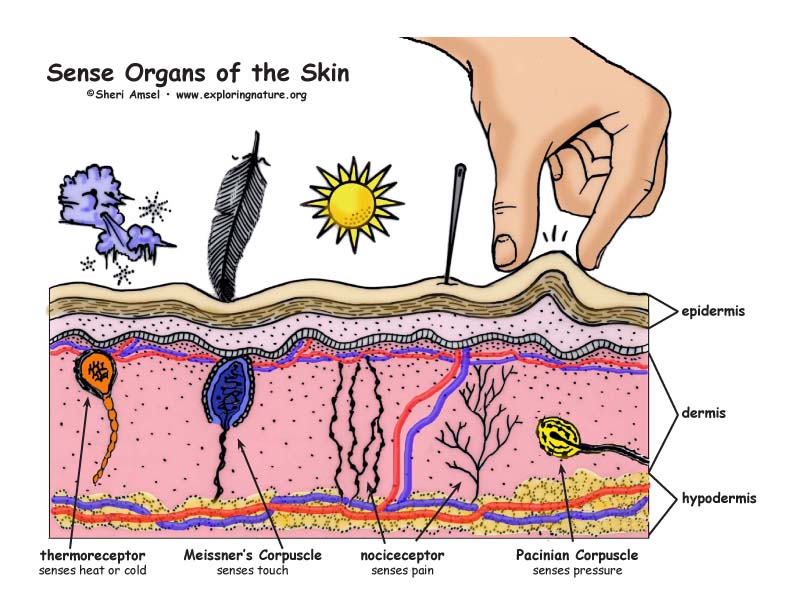
The skin, our body’s largest organ, serves as a remarkable interface between our internal environment and the external world. It is equipped with an intricate network of sensory receptors that enable us to perceive and respond to a wide range of tactile sensations and temperature variations. In this comprehensive article, we will explore the fascinating mechanisms behind how the sense organs in the skin detect temperature and touch.
The Complexity of Skin
Before diving into the specifics of sensory perception, it’s important to appreciate the complexity of the skin itself. The skin comprises three primary layers: the epidermis, dermis, and hypodermis (subcutaneous tissue). These layers contain a variety of specialized cells and structures, including hair follicles, sweat glands, and an extensive network of nerves and sensory receptors.
Sense Organs for Temperature Detection
1. Thermoreceptors
Temperature sensation is primarily mediated by specialized sensory receptors called thermoreceptors. These receptors are found throughout the skin and are responsible for detecting both hot and cold stimuli. There are two main types of thermoreceptors:
- Cold Receptors: These receptors, also known as cold fibers, are more active at lower temperatures. They are particularly sensitive to temperatures below normal body temperature.
- Warm Receptors: Warm receptors, or warm fibers, become more active as the temperature rises and are sensitive to temperatures above normal body temperature.
2. Free Nerve Endings
Apart from specific thermoreceptors, free nerve endings located in the skin’s dermis and epidermis play a crucial role in detecting temperature changes. These nerve endings are sensitive to temperature variations and transmit signals to the brain when the skin encounters hot or cold stimuli.
Sense Organs for Touch Detection
The skin is also equipped with various sensory receptors that detect touch and pressure. These include:
1. Meissner’s Corpuscles
Meissner’s corpuscles are mechanoreceptors found in the dermal papillae of hairless skin, especially in the fingertips, palms, and soles of the feet. They are sensitive to light touch and low-frequency vibrations. When you lightly run your fingers over a textured surface, Meissner’s corpuscles are responsible for the sensation.
2. Pacinian Corpuscles
Pacinian corpuscles are deep mechanoreceptors located in the subcutaneous tissue and are highly sensitive to deep pressure and high-frequency vibrations. When you apply firm pressure to the skin or experience a rapid mechanical change, such as a tap or a sudden touch, Pacinian corpuscles are activated.
3. Merkel Cells and Discs
Merkel cells and Merkel discs, found in the epidermis, are sensitive to sustained pressure and texture. They are particularly abundant in fingertips and contribute to our ability to perceive fine details when touching objects.
4. Ruffini Endings
Ruffini endings are mechanoreceptors located in the dermis and are sensitive to skin stretch and continuous pressure. They play a role in the sensation of skin deformation and are involved in perceiving the shape of objects when holding them.
The Transmission of Sensory Information
The transmission of sensory information from these receptors to the brain is a complex process that involves nerve signals. When a sensory receptor, whether for temperature or touch, is stimulated, it generates electrical signals. These signals are then transmitted along sensory nerve fibers to the spinal cord and ultimately reach the brain’s sensory processing centers.
In the brain, the information is processed and integrated to create our conscious perception of temperature and touch. Additionally, these sensations often trigger reflex actions that occur without conscious thought, such as withdrawing your hand from a hot surface or automatically adjusting your grip on an object to prevent it from slipping.
Conclusion
The skin is a remarkable sensory organ, richly endowed with specialized receptors that allow us to perceive temperature and touch. Whether it’s detecting the warmth of the sun on our skin, the coolness of a gentle breeze, or the sensation of a soft caress, these sensory experiences are a testament to the intricate mechanisms at play within our skin. Our ability to navigate and interact with the world around us is greatly enhanced by the sense organs in our skin, providing us with vital information about our environment and facilitating our everyday experiences.



